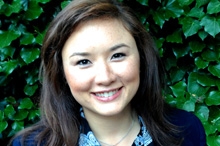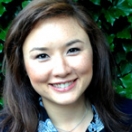

Eri Gentry is being honored as a Champion of Change for her dedication to increasing public engagement in science and science literacy.
One of the biggest challenges I’ve faced is how to become involved in science as a non-scientist. When I was little, I wanted to be a scientist. The evidence? A self-portrait done by a seven year-old me in an array of colored pencil: me in a lab coat and enormous, round glasses, with the word SCIENTIST, in deliberate seven year-old caps, underneath.
When I was 11, officially middle-school age, I wanted to be a stockbroker, a writer, an inventor, and an actress. Oh yeah, a scientist, too. I grew up in what I call a “small, poor, prison town in the middle of the desert.” It’s the kind of place that doesn’t always put opportunities in front of you, but it’s also the kind of place that lets you run wild with dreams.
In college, I remember choosing Economics over Biology as a major because “I wanted to be social.” Along the way, I had gotten the now funny impression that scientists worked alone, in dark places, from the only scientist I’d met in my life – a high school Physics teacher who started the first class by telling us she was there to teach underprivileged kids.
Shortly after entering the working world, where I no longer had access to classes, labs, or professors, I realized I wanted to do science, not finance. The problem was that there was essentially no way for me to do that. I eventually found a small, non-profit biotech lab, SENS, that took me in as a volunteer. At SENS, scientists were working around the clock with a passion and intensity I had never before seen to cure diseases of aging – to save people’s lives. I may not have known how I could help, but I knew this was the place I wanted to be. The place where I was fulfilled.
Through volunteering, I ended up cofounding a non-profit cancer research lab, Livly, with the Director of Research at SENS, after a colleague of ours died from esophageal cancer, unable to even try an experimental treatment in the states. We worked on improving the metrics around the experimental treatment he might have gotten in the only place we could afford: our Mountain View, CA garage, an amalgam of self-built tools and equipment bought on eBay and scavenged at big pharma liquidation sales.
Not content with working alone in our garage, I started holding DIYbio-themed meetups at my house in 2009, which anyone with any interest whatsoever in science could attend. Chemists, artist, software developers, tech entrepreneurs, and even some original Homebrew Computer Club members attended the meetups, and they quickly grew out of our house and into the local hackerspace, Hacker Dojo, which allowed community members to hold events in their large space.
Talking to the folks who attended my meetups, I found that they, too, had discovered a passion for science later in life and didn’t know how to get pursue it without giving up their jobs and/or negatively impacting their families. Their needs were almost always the same: they needed access to equipment, a place to work, more education, and people. When I thought of how to fill their needs, Hacker Dojo came to mind, a place people congregated to work, to socialize, to “meet cofounders of companies they didn’t even know they wanted to start,” as Founding Director, David Weekly puts it.
A hackerspace devoted to biology had never been attempted before, but wasn’t that likely because people stopped getting exposed to science outside of academia? What if the former could help fix the latter, I wondered. The climate is right: tools are inexpensive (enough), people are interested in DIY science, and a modification of the hackerspace model would work to fill people’s needs. It all made sense, and it felt like a mission that had to be accomplished, so I joined forces with five “biohacker” friends to start BioCurious, the world’s first hackerspace for biology.
We used the then brand-new Kickstarter crowdfunding platform to raise money and, with hundreds of backers from around the world, and hundreds more meetup members, we opened a 2600 square foot laboratory in Sunnyvale, CA that is open 7 days a week and lets anyone, at any level join for $100 a month. We have biotech classes, community projects, public science safety classes, glowing algae, scrappy entrepreneurs, and six year-old geneticists. BioCurious is completely volunteer-run and member supported. Many said it wouldn’t work. It doesn’t simply work – it thrives. Innovative strategies for science are ideated and attempted every day, and it wouldn’t be possible without a community lab to serve as stepping-stone between academia and home life. We may be the first hackerspace for biology, but that’s just the beginning. People write to BioCurious from around the globe asking for advice on how to start their own biohackerspaces. It makes me wonder, what would the world look like with a community lab in every neighborhood?
Eri Gentry is the Founding President of BioCurious and past CEO of Livly.


